- English
- Русский
In the year 1993, the world of martial arts was turned upside-down. The UFC 1 event took place, pitching fighters practicing different martial arts against each other with the idea to find out what the best fighting style was. It was a “no rules, no weight classes” tournament, so it was very reasonable to assume that some huge brawler on steroids was going to dominate the event, regardless of fighting styles. (In fighting sports, size and strength are realistically the biggest factors, hence the existence of weight classes.)

That’s not Kuro after a workout – it’s Ken Shamrock, one of Royce’s opponents in UFC 1
What happened, however, was quite different. Royce Gracie, who weighs 80kg (175 pounds) and has an unimpressive physique compared to some of the other competitors, was able to dominate the tournament. Later on, he won UFC 2, UFC 4 and had a draw in the final of UFC 5, achievements more impressive even than Na’Vi’s performances at TI1, 2 and 3.
Without question, Royce proved that Brazilian Jiu-Jitsu, at the time, was the superior fighting style. In our language, he came into these tournaments with the superior strategy and broke the meta.
It is even said that the Gracie family was so confident in their BJJ, that they intentionally sent a smaller fighter so that his win would be more impressive and people wouldn’t be able to attribute it to his size or strength. So what made BJJ so dominant?
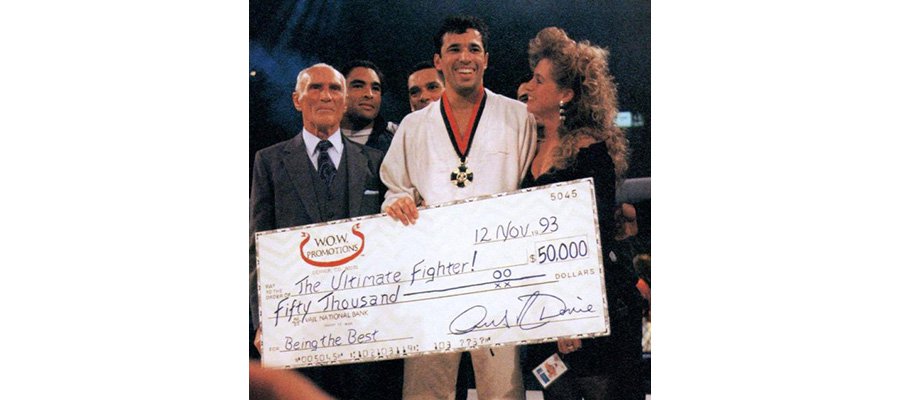
Royce Gracie after his win
John Danaher (a legendary coach) described BJJ as a systems-based approach to fighting, a step-by-step strategy:
STEP 1: Take the fight to the ground at all cost. There your opponent wouldn’t be able to generate explosive kinetic energy (aka kicks and punches), which is the biggest initial danger.
STEP 2: Get past your opponent’s legs, which are the strongest and most dangerous part of the body - you can get kicked in the face with a lot of force even by an opponent on his back.
STEP 3: Get in a controlling position – take his back or control his torso. This leaves you with a lot of offensive options, while your opponent has almost none.
STEP 4: Finish the fight – usually by attacking your opponent’s neck or arms with chokes or joint locks.
Back
then, if this fighting system (or strategy) was unfamiliar to you, you
basically didn’t stand a chance despite your size. You don’t know how to avoid
getting taken down, how to prevent your opponent from establishing control and
how to counter the finishing moves. This was the new fighting meta, which led
to Royce’s dominance in the first few UFC events.
Dota goes through similar evolutions quite often – rarely so dramatic, but equally significant.
To use a similar step-by-step approach, to win in Dota you have to:
STEP 1: Establish map control, control the available resources on the map and prevent your opponent from controlling them.
STEP 2: Out-farm your opponent by exploiting your map control.
STEP 3: Finish the game, use your resource advantage to take the enemy base and throne.
The key to victory is resources and you get them by controlling the map.
Historically, different teams were able to invent a new meta and win tournaments by completing these objectives in an innovative way. By having a superior new strategy, you are not allowing your opponents to simply out-play you in the traditional way, in the same way as Royce didn’t allow his opponents to simply physically dominate him.
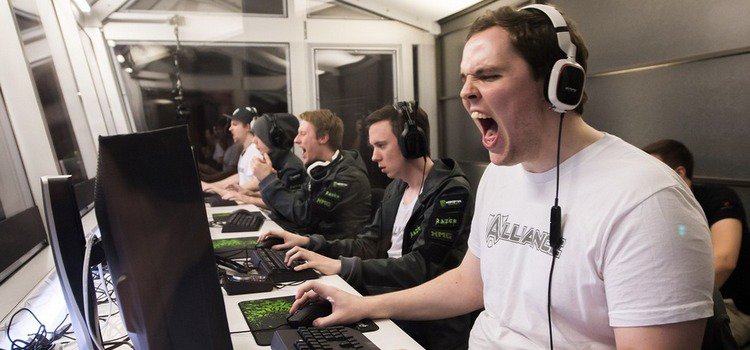
As Ver explains in his brilliant Strategy over Skill analytical piece, the key to the dominance of Alliance was in how well they were able to protect their own territory, how efficiently they exploited the resources in it, and how they used their resource advantage without taking any unnecessary risks to finish the game.
Many argue that at the time of TI3, Alliance didn’t have the best players mechanically, yet their strategy made them one of the most dominant teams in competitive Dota history.
As one of the innovators of the turtle & split-push play style (aka Rat Dota), their game plan was:
STEP 1: Protect your territory. Draft heroes with anti-push and protect your towers. Take mostly defensive fights.
STEP 2: Use your own territory as efficiently as possible. By having your towers up for as long as possible, you establish control of your own jungle. Use this control to farm the jungle both with your semi-support (Akke or more commonly EGM depending on the hero) and offlaner (Admiral Bulldog) and out-farm the enemy team.
STEP 3: Rat and out-farm - draft carries who are good at split-pushing (the old PL, LD, NP, usually played by Loda and Admiral Bulldog). While your team is defending your towers, your cores are out-farming the enemy team and are claiming free objectives by split-pushing.
STEP 4: Finish the game with a solid resource advantage by taking as little risks as possible. Split-pushing comes into play again, but traditional 5-man pushing is also employed when Alliance have a big enough lead.
Their innovation was in how successfully they defended their own space on the map in the early-mid game, how efficiently they farmed it and how well they utilized split-pushing and turtling in order to win the game without taking big risks.

In TI4 the two favorites were EG and DK – both incredibly mechanically gifted teams, who have been winning tournaments all year.
Yet, VG and Newbee started using a notorious new 5-man Dota strategy, which helped them dominate the tournament with consistent 20-minute wins.
STEP 1: Ensure a good start. Draft resource-independent heroes which are good at fighting from the beginning of the game to ensure you have a fight advantage early on.
STEP 2: Gather as 4 or 5 very early and start pushing. Draft strong early game pushers and team-fighters and start pushing the enemy towers from very early on before the enemy team is ready to defend and before their carries can split-push fast enough. If you have a mobile 1st position hero, farm with him and only join when the fight has started (the old Morph and NP were popular carries for this exact reason.)
STEP 3: Use the established map control to finish the game as early as possible. After pushing all enemy towers, you continue the 5-man push into the enemy base before your opponents have the needed items to fight back.
The only reliable counter to this strategy at the time was the same strategy and as a result, the two teams that were using it the most met in the finals. 25-minute one-sided games were not a good news for pro Dota, so IceFrog was forced to introduce big changes to the game to counteract this 5-man hyper-aggression.

Winning a tournament isn’t a guarantee that you innovated the meta in some profound way. Sometimes, teams simply have better mechanical skill, team-play, and understanding of the current meta and they use it to dominate.
A great example of this is VP-s legendary run at The Summit 7, where they didn’t draft a single hero more than once until the grand finals and still won the tournament. This was not a formulaic approach to Dota designed to beat mechanically better teams – this was a simple display of total versatility in terms of strategy, tactics, and execution.
Yet, dominant teams like VP, TI4’s DK, TI5’s Secret, etc. often fall short when they are faced with the newest strategic innovation, which often comes at The International.
Did Liquid have a systems-based approach that they used in TI7 or were they simply the most skilled team in the current meta?
They certainly had much more versatile picks than Alliance in TI3 and more variable games than Newbee in TI4, which points toward the latter. Nonetheless, it doesn’t hurt to dig a bit deeper and see if we can find their strategic keys to victory.
Let’s take a step back, however – you cannot understand a team well enough without first understanding its players:
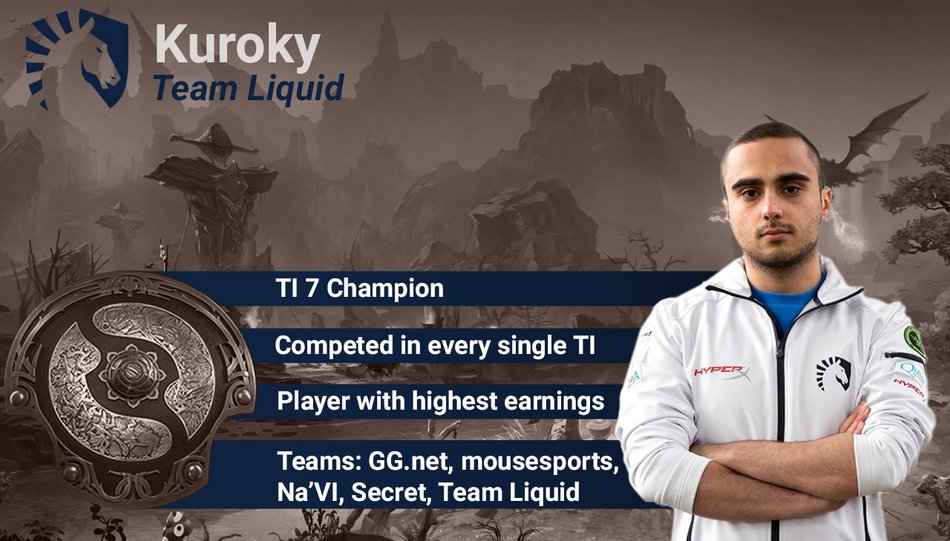
In terms of strategy, Kuro’s simple involvement in the team doesn’t tell us much. He has been in the scene long enough to have done it all – he has switched positions, teams, meta-games…
Shortly after Liquid’s roster formed, they attempted to use strategies where Kuro would play the carry if they are going for a 5-man push lineup (e.g. with Drow Ranger, Luna). They didn’t find a lot of success this way, however, and scrapped the idea.
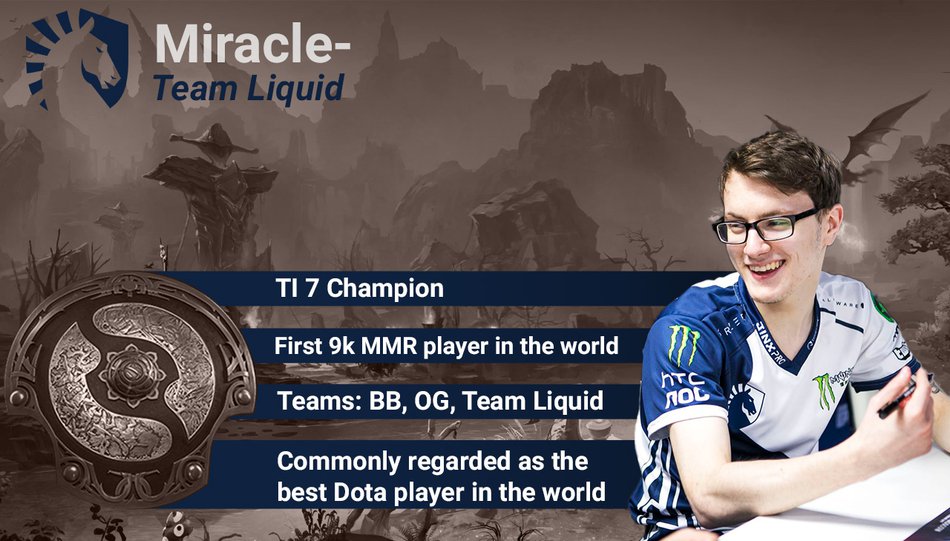
Many top teams had two key ingredients – a cerebral captain and a mechanical prodigy: Puppey & Dendi; Faith & Ferrari 430; PPD & Arteezy/Sumail; Solo & Noone/Ramzes. The Kuro & Miracle duo certainly fits this description.
Despite playing mostly in the mid lane, Miracle is undoubtedly a 1st position player. When he was playing in OG, Moonmeander jokingly said: "this is the environment Miracle- is used to playing in his 8000 Ranked MM games. He ends up playing Anti-Mage or SF and carries the game 1v9. We are simply re-creating the environment in which he excels: Miracle + four 4k MMR teammates"
So, having Miracle in your team is a predisposition to play in the 4 protect 1 style. Liquid did, in fact, prioritize the farm of Miracle a lot – it is the main reason Matumbaman played mostly carries that don’t need a lot of help like Veno, Necro or Lone. Nonetheless, it would be wrong to say that they played 4 protect 1 – even though he is often Liquid's win condition, the games rarely fell entirely on Miracle’s shoulders.
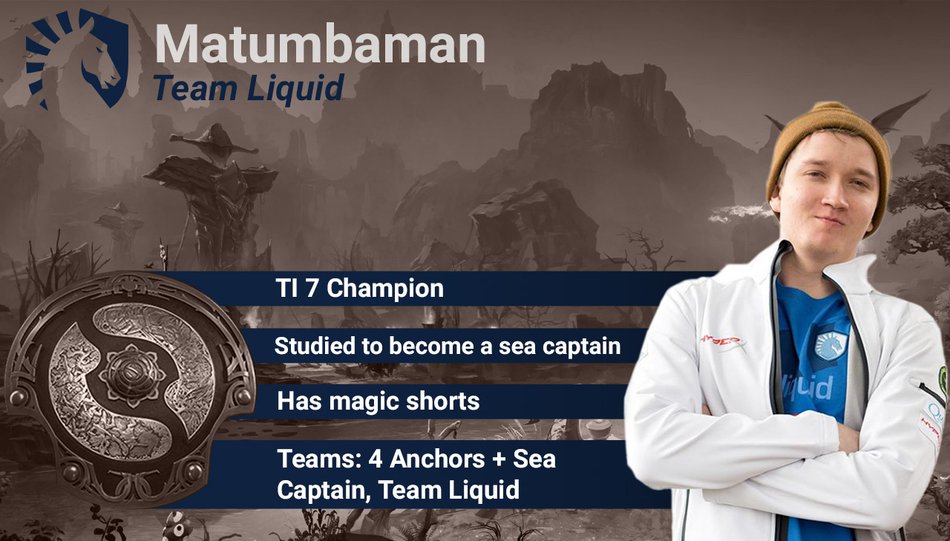
Matumbaman embraced his destiny as a 2nd position carry player and despite probably not having as much fun as Miracle, his incredibly consistent performances served as a backbone for the team and their strategies. Some of Matu’s most played heroes in the tournament are also some of Liquid’s most successful:
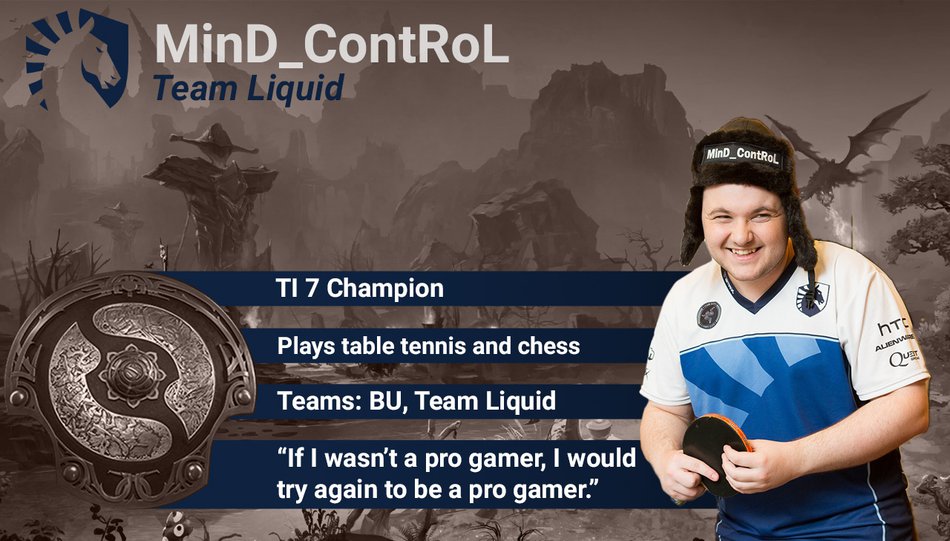
One of the more unknown players on the roster, once he got picked up by Liquid his career skyrocketed.
Initially, he was criticized for being a weak link – likely a result of the fact that he received very little help from the supports as they were focused on Miracle and GH often plays very greedily. It’s hard to shine when you are left with very little space of your own.
Nonetheless, he seemed to get used to this fact. More importantly – he managed to find a lot of success playing more greedy offlaners (his split-pushing Beast Master, NP, and LC) when GH was playing the space creator. Liquid developed a playstyle in the mid game in which MC is taking the dangerous farm, pushing out the lanes and drawing the attention of the enemy team while Miracle is taking the safe farm, which ensures that he rarely dies and stays on top of the net worth graph.
(MC’s Prophet arguably carried Liquid a couple of games and some pros point to him as the best player in TI7.)
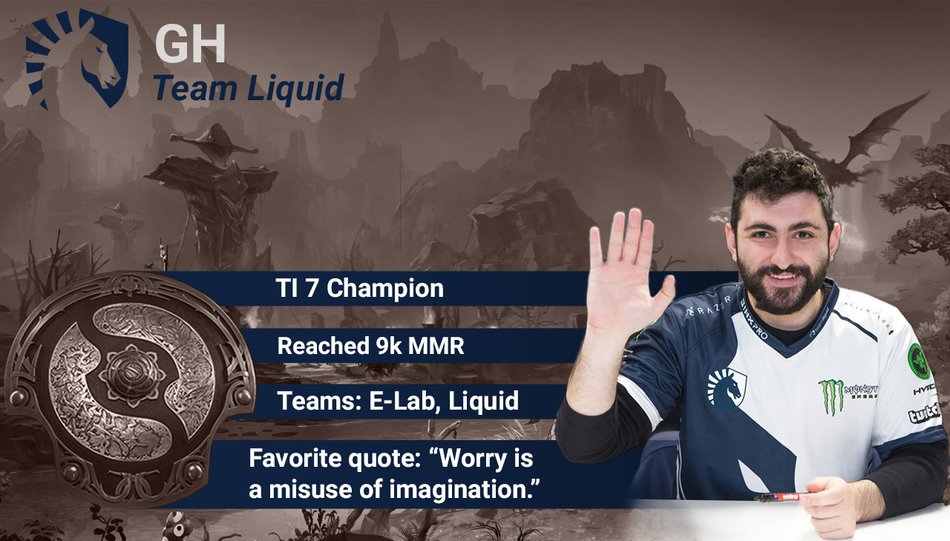
GH was a new face in the tier 1 pro scene and it took the team some time to adjust to him: initially, they even attempted using him as a pos. 1 with his Naga Siren, unsuccessfully.
In TI7, however, GH was a key part of the team and his incredible play with IO, KotL and Earth Shaker made it very hard for enemy teams to ban against Liquid. It was the TI3 Admiral Bulldog conundrum all over again.
It is quite unique for a support player to have that much drafting impact and it allowed Liquid to almost always get the strategy-backbone picks they wanted for Matumba and MC. Having three key heroes (instead of two) at the same time meant that one of GH’s heroes was always available in the first picking phase and the team could easily build the strategy around it (at TI7 each team had only two banns in the first phase).
It also allowed Liquid to use Miracle’s versatility and almost always pick his hero as a last-pick-counter to the enemy draft.
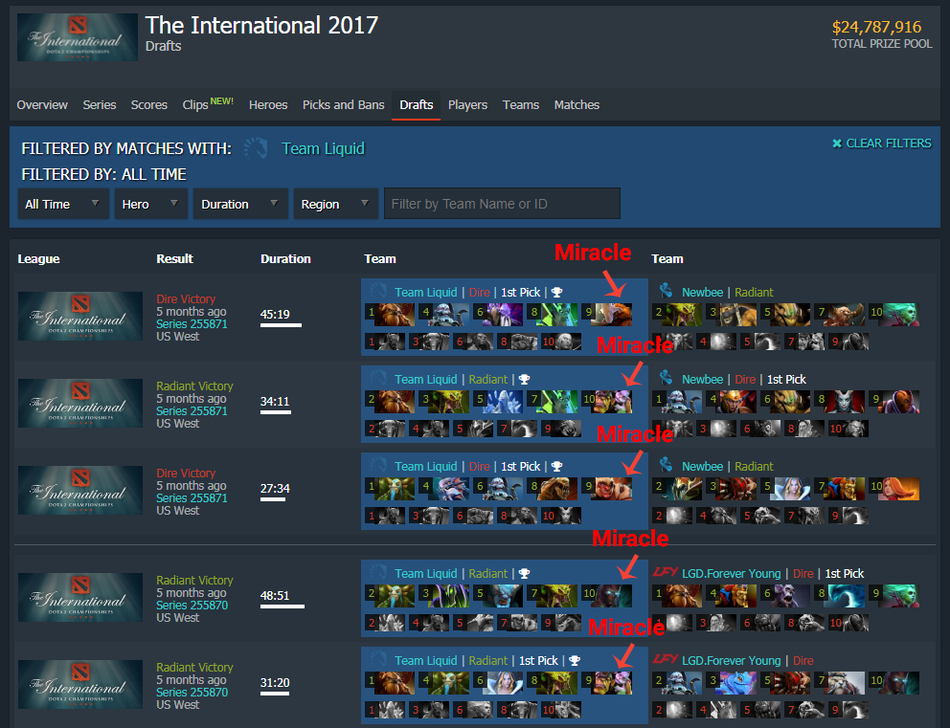
In that sense, if MC was the best player at TI, then GH was the most strategically impactful.
Even though, as we mentioned, Liquid took some time to define themselves as a team and find what works for them, they had some tournament success prior to the International and they walked into TI with the confidence of a champion: a key ingredient for any team. This confidence was probably what allowed them not to crumble mentally after falling to the losers’ bracket and after many hard series (against Secret, VP, and LFY).

When watching Liquid’s TI games, one thing stuck out to us the most: Liquid seemed to have some magical ability to be successful in their aggressive moves even when they were behind in the game.
This “comeback potential” was partly due to their tactical acumen and movement on the map: when they are behind, they don’t lose objectives without gaining anything in return. They often trade equally, using the split-push heroes that they draft in almost every game (MC’s Prophet, Matu’s Lone Druid and Lycan, GH’s IO or KotL combined with one of the pushing cores).
Moreover, when taking aggressive fights they take them in enemy territory after pushing out the waves. This means that even if they trade unfavorably (let’s say they lose three heroes, the enemy – two), the enemy is not in position to claim objectives and in this way Liquid doesn’t lose significant map control.
These two practices are not something new – other good teams use them as well occasionally. One thing that truly stands out, however, is how insanely well Liquid uses the timings of their lineup.
This is most obvious when GH plays KOTL – the team knows that when he has Aghanim’s (usually around the 20-25 minutes mark) and when their frontline core has some fighting items (e.g. BKB) it is time to push the enemy base. The KOTL Agh’s is a timing they aim to exploit even when they are not significantly ahead in resources.
Game 3 vs Team Secret is a great example of this. It’s an elimination game (the series is tied 1-1) and it doesn’t start great for Liquid: at some point, they are down 10-2 kills and are slightly behind in resources. Despite this, they have the confidence to capitalize fully on their KOTL Aghanim’s timing.
On the 23rd minute of the game, Liquid has a 3k gold lead despite being down on kills (a relatively insignificant lead). Nonetheless, they have Agh’s on KOTL and Aegis and BKB on Miracle’s Troll and they are ready to push the enemy base despite everybody on team Secret being alive:
Liquid manage to claim two T3 towers and the top barracks of Secret and pretty much secure the game in one bold, insanely well-timed move.
By the time the grand final came, it truly looked like Liquid has found their stride and the key to victory in this tournament, despite coming from the lower bracket. One thing that makes Liquid so scary in TI7 is their ability to learn from past defeats and get stronger as the tournament progresses. This is also not unique: Na’VI, EG, OG – all of them have made impressive lower bracket runs, but in TI7 it seemed like Liquid is the team that is improving, evolving and finding themselves the fastest.
A great example for this is their first game in the grand finals against Newbee. They pick Lich and Life Stealer - two heroes that they don’t use as commonly as some of their more established picks (ES, Necro, Veno, NP, etc.). They do it to counter Newbee’s Bloodseeker carry strategy: Liquid have seen how LFY used LS + Lich to win their game against NB, and decide to incorporate the same counter into their own draft. When LS gets ruptured, he can stand his ground and if he gets focused – use Rage and man-fight. Moreover, he can enter a creep and move without taking Rupture damage. The Lich is a great combo with LS because it secures the laning stage and provides a very useful protection against physical damage (Ice Armor).

This game is a perfect example of GH’s impact in determining how the drafting phase unfolds. Newbee are forced to ban ES & Wisp, which leaves his KOTL in the pool and more importantly – MC’s NP.
Liquid pick NP, which has been central to their strategy so far, and follow up with a roaming 4th position Slardar for GH (it is quite likely that they don’t want to commit to a KOTL strategy when the enemy team has Nyx and BS and Slardar has amazing synergy with LS, who they intend to pick).
As we mentioned, Liquid pick up the Lich + LS combo to counter the BS strat. As a bonus, LS is a great pick against NB’s Bat – with Magic Stick and Rage it is very hard for the offlane Bat to pressure your carry LS with Napalm, which frees up your supports to rotate and secure the other lanes (in particular GH’s Slardar).
As usual, Liquid pick Miracle’s hero last. Troll in this game has great synergy with their team:
It is quite fair to say that Liquid start the game with a big draft advantage. They have a counter to Newbee’s BS strategy and they have an overall playstyle of the lineup that they are confident with – the split-pushing and pushing of NP and Troll, the active roaming of Slardar and the fighting core LS of Matu.
This is pretty much a flawless drafting phase: Liquid are using heroes on which their players are confident. All their heroes have great synergy in all stages of the game – the lanes look favorable and with proper movement and ganks they should be able to secure a lot of map control and out-farm their opponents. Finally, they have decent counters for the enemy heroes and with their pushing potential, they should be able to finish the game easily.
Drafting lineups with heroes who are great at pushing has been a constant for Liquid at TI7 and has paid big dividends – the team is able to secure the win very quickly when they establish a resource advantage. Throwing a lead is very hard when your lineup is great at destroying the enemy base in seconds.
The lanes favor Liquid:
PS: Warding
Liquid focus their lane wards in the mid and offlane. The reason for this is because the safe lane should be a free lane for Life Stealer and there is a very slim chance he dies, even without wards. If the enemy supports rotate, he can easily just Rage and TP out.
The offlane ward is blocking the big camp and gives vision to the area. Blocking the camp forces the enemy supports to spend the early game in the lane and fight MC because they have nothing to pull.
Sidenote: something interesting that might come into play is that usually supports want to zone out Furion right from lvl1 (as he is not very strong at that point). So, if you have blocked the big camp and the supports come to fight you right away, they might miss the chance to see if their neutral creep camps are blocked or not and to buy Sentries if they don’t have any. Fighting with the NP might mess up the creep equilibrium and if this happens - you don’t have a big camp to pull.
After an amazing early game for Liquid, they attempt to seize map control as fast as possible (again, exploiting timings).
At minute 10:30, as soon as Slardar reaches lvl10 (and with a lucky DD for Troll), they immediately smoke into the Rosh pit. Unfortunately for them, the Rosh attempt was spotted by Nyx, so Liquid doesn`t commit too hard and backs off. If the Nyx wasn’t there at the time, this could have meant an extremely fast Roshan for Liquid, which would give them the opportunity to be aggressive, push and claim even more map control.
At minute 15 note how Liquid are smoking and grouping up behind Miracle mid because they know that Bat Rider will have his Blink at this point and will try to jump on Troll – they understand the timing of the enemy team as well and are prepared to counteract it. Liquid was ready, but unfortunately, due to bad execution (GH probably missclicked), they trade 2 for 2 instead of winning the fight decisively.
The 18 min Rosh fight demonstrates great positioning by Liquid. Every player knows exactly where to be and what to do in order to secure Rosh and win the fight.
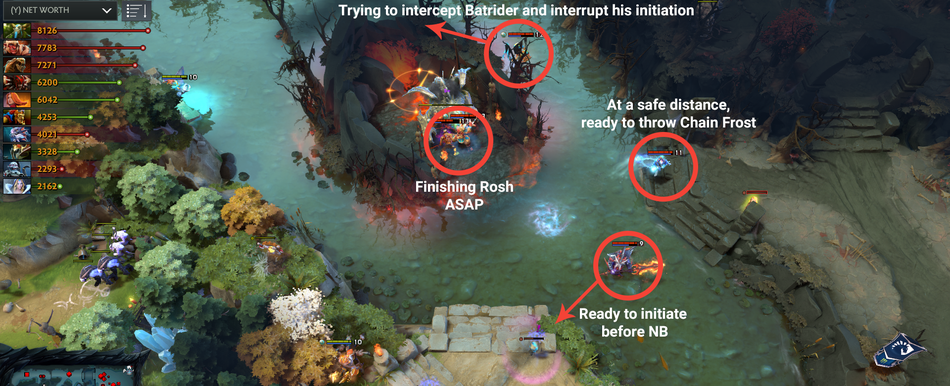
After this Rosh and with the amazing map control that Liquid have it was just a matter of time for them to finish the game. Newbee were scared to leave the base if they don’t see Lifesteal even with wards on the map - first because of Slardar bombs and second because of Furion with Shadow Blade and a possible global Lifestealer bomb.
There is an argument to be made that Liquid’s success in TI7 wasn’t a result of any profound innovation in Dota. Nonetheless, it seems like they had such a good understanding of their own strengths that they approached games with a similar set of “rules” to carefully balance playing a familiar strategy and countering the enemy team.
Thanks to GH’s impact with his three key heroes (ES, KOTL, and IO) and MC’s impact with NP, Liquid pretty much started every game with a draft advantage. After seeing what was banned out, Kuro could open the draft up with his usual strategic picks (GH’s pos. 4; Matu’s self-reliant pos. 2; and MC’s space-creating and split-pushing pos. 3) and close it with the perfect pos. 1 counter-pick for Miracle, their win condition.
STEP 1: Ensure a good start. Draft at least one hero that can create space from early on (usually played by GH or/and MC). Draft a 2nd position hero that doesn’t need a lot of help in the lane (Necro, Veno, etc.) in order to free up GH and allow him to either roam (e.g. with ES/Slardar) or farm (e.g. with KOTL).
STEP 2: Draft a lineup capable of claiming objectives and use it to secure map control. Always draft a lineup that is comfortable at fast pushing, split-pushing and claiming Roshan and use your good start to methodically gain map control.
STEP 3: Exploit the peak timings of your draft fearlessly to secure the victory. Draft your 1st position hero last, as a counter to the enemy lineup. Use this hero’s timings and other important timings of the team as a whole (e.g. KOTL’s Agh’s) to secure the victory by abusing the pushing power of your lineup.
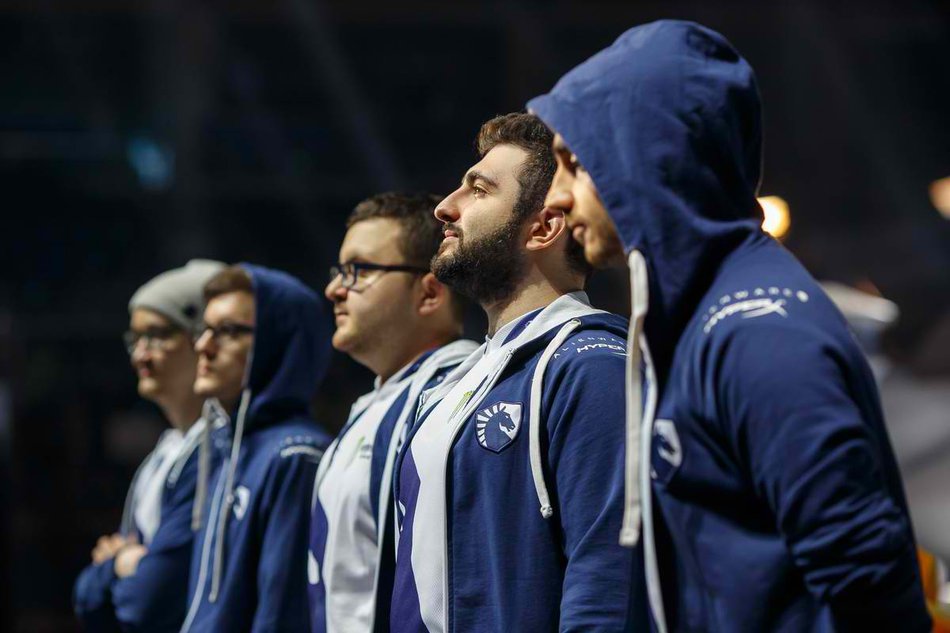
After TI7 a lot of people expected Liquid’s performance to fall off (as was the case for most previous TI champions, i.e. the TI winner curse). There are two main reasons for this trend:
Psychology: First, lack of motivation. After having achieved your goal, it’s hard to make yourself work as hard as before. Liquid described it as a feeling of emptiness, but even if this affected them at the beginning of the season, they most certainly got over it quite quickly and found their motivation again.
Strategy: Second, a shift of the metagame. Generally speaking, after TI a balance patch comes out which nerfs the most popular picks and strategies, which in turn shifts the meta. Logically, the winning team is usually the one to suffer the most from the changes.
To win TI you need to be at the top of the meta at the tournament. To stay dominant, however, you have to change your game plan in order to stay relevant, which is very hard to do. Many teams, most notably Alliance (as well as Royce in our MMA example), weren’t able to do this well enough, which quickly led to their decline.
Even if the patch doesn’t nerf the strategies you like to play, other teams will most certainly study you and imitate and counter what you are doing.
A good example of this is the cheese picks – Liquid was one of few teams who drafted Brood (and Huskar) very often at TI7. At TI8, however, most teams had a good Brood player and some teams even picked Brood from the early stages of the draft, which meant that Liquid was not unique in using those "cheese" strategies anymore. Many teams even integrated Meepo into their cheese picks (most notably Secret with Ace) – something Liquid didn't do.
You need to constantly change and stay ahead of the curve to stay on top.
Quite well – they had a strong season, won the Super Major before TI and managed to place high at TI8. So, what did they change in their playstyle?
They kept certain aspects of their game plan which are not as meta-game reliant, but they had to ditch other things they did often and to adopt a new playstyle:
They kept drafting a consistent, non-greedy 2nd position hero for Matu, who doesn’t require a lot of support. Liquid played core Veno, Necro and Viper just like at TI7, despite the fact that those heroes were not as common picks in the current meta. (An exception to this is when Liquid pick Brood, simply because Matu is their Brood player.) Having a non-greedy 2nd position hero means your other two cores will have more space on the map for farm in the mid-late game. This has always been true, and at TI7 Liquid exploited it by drafting split-pushers for MC like NP and his Beast, while at TI8 they used it with heroes with carry potential like Clinkz, WK, Ursa, etc.
It’s not a good idea to leave a core alone in the side lanes in the dual lane meta, so Matu played mid often and when he was in the side lanes - he got more help from the supports. In TI7, Matu’s non-greedy core freed up the supports to be active in the early game. In TI8, however, they had to spend most of their time in the side lanes. This could have been a detriment for Liquid because they couldn’t use one of their best tools as freely – GH’s roaming and ganking. Solo said that this shift in the meta damaged VP’s performance because they were extremely successful with Rodjer on a roaming supp. The argument could be made that Liquid had the same problem with GH.
This,
combined with the additional first phase hero ban (three instead of two), meant that GH could not have
the same draft impact as in TI7. He still played excellently, but he could not
win drafts for Liquid just by having a few dominant heroes as he did in TI7.
MC also had to shift his playstyle simply because the offlane changed heavily. The addition to dual lanes meant that at TI8 strong laners with carry potential (Ursa, WK, Weaver, Ench, Clinkz) were the standard offlaners. Those are a different type of heroes than his previous split-pushing Beast or NP or initiators like DS and Shaker. MC, similarly to GH, had to shift his playstyle and to rely more heavily on ganking and skirmishes to create space rather than split-pushing.
The term “win condition hero” actually became common after TI7 when more and more teams started making the perfect situational last-pick for their pos. 1 player. It could be argued that Liquid’s drafting for Miracle is partly to blame for this becoming common practice, especially when a team has the last pick. Liquid continued doing this at TI8, but they were one of many teams to do it.
Moreover, the dual lane meta enables multiple cores to scale with items relatively equally (sometimes all three), which means that a single player and a single hero rarely can decide the game on their own, making the last pick a bit less impactful (unless it’s a cheese pick).
Liquid attempted to set up Miracle to be the true win condition with heroes like PL or Alchemist, but with mixed results. Invading the enemy jungle in the early-mid game is a standard practice for the TI8 meta, which means that you rarely have the luxury to farm uninterrupted even if you are a pos. 1 and your allies are trying to create space. You either have to fight offensively on the other side of the map or you have to survive against lots of pressure on your own side. Some carry players nowadays even say that the enemy jungle is the safer place in the mid game.
This was most obvious in Liquid’s game vs LGD where Miracle (0-8-1) played Alchemist against LGD and the Chinese team didn’t give him even an inch of free space to farm, constantly pressuring him with Maybe’s Bloodseeker (16-0-11) and their supports. In the video below, PLG.LGD kill Miracle- twice behind his tower on minute 6-7 (they kill him, steal his stack and afterward kill him at the Shrine, where they know he'll try to find some farm). Miracle cannot freely farm even the camps closest to his base before the end of the laning stage.
Liquid still placed very well at TI8 – top 4 is quite the respectable achievement. They understood the meta quite well and adapted to it. On the back of their extremely mechanically gifted players, they out-played a lot of teams and were able to go far.
They were not the trendsetters at TI8, however, as they were at TI7. This title belongs to LGD and OG (who deserve a deep analysis of their own).
Puppey said many years ago that new patches buff and nerf teams – if you’ve always been good at certain playstyles and heroes, it is quite logical that a patch that favors this playstyle will make you stronger. The best teams, however, are the ones who can adapt to the many changes and stay relevant. Team Liquid has proven to be one of those teams without a doubt.
The champions, however, are the innovators - the teams who walk a step ahead of the rest and change our understanding of the metagame. Whether Liquid will be able to innovate once again remains to be seen in the coming season!
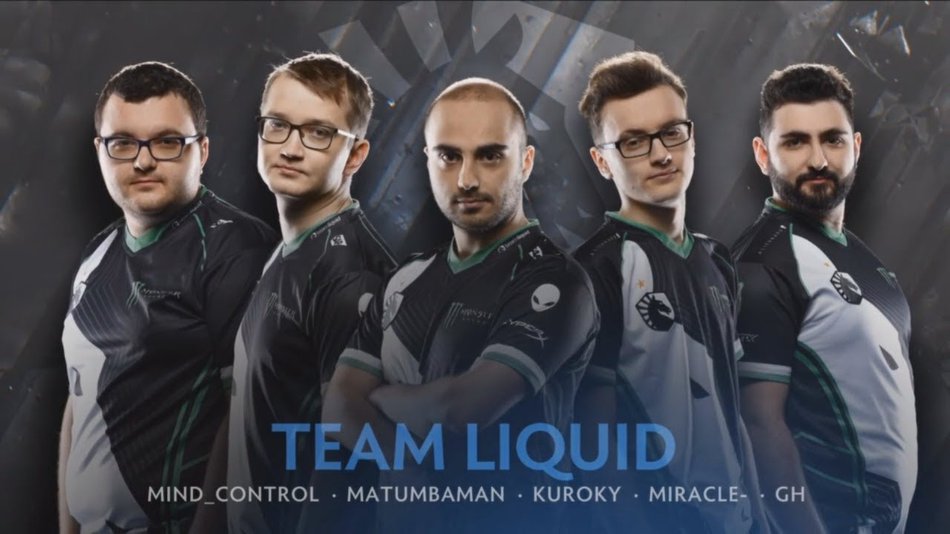
We started the TI7 section of this article by going over all the Liquid players for a reason – the members of the team determine the team’s playstyle. So, we can’t start the TI9 section without mentioning one huge big change: w33 replaced Matumbaman for TI9.
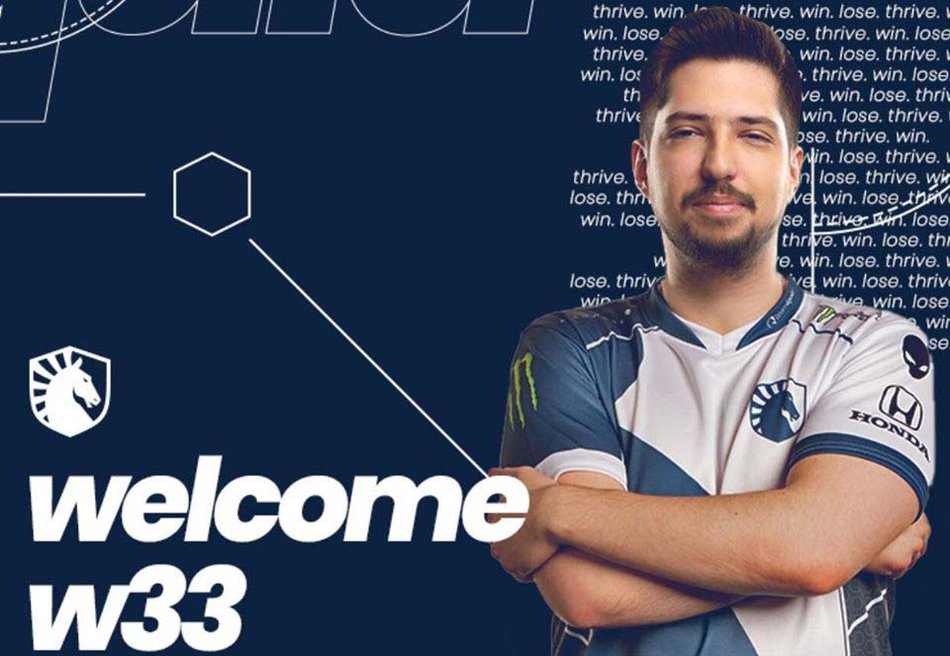
This has big implications for the team.
Interestingly, as we’ll see from below, in TI9 Liquid swapped the pos. 1 win condition hero between Miracle- and w33 much more often than they did between Matu and Miracle. This in itself is good for the team as it gives them more versatility and less predictability. That said, it has another implication – MC gets less space on average than before and rarely plays his greedier split-push or semi-carry pos. 3 heroes that he used to play.
The priorities of the team are visible from the heroes they pick most frequently:
Tide, 8 Picks. Team fight strength; Counter-initiator; Non-greedy pos. 3; Aura buyer;
Templar Assassin, 6 Picks. Rosh potential; Flash farmer; Nuke damage; Wave clear, some anti-push;
Rubick, 6 picks. Versatile support – active roamer or lane support; Team fight impact; Wave-clear;
Shadow Shaman, 4 picks. Push + Rosh potential; Versatile support – lane support or more active/greedy roamer; Wave-clear;
Chen, 4 picks. Active support; Aura buyer; Team fight strength;
Tiny, 3 picks. Nuke damage; Space creator; Wave clear;
Elder Titan, 3 picks. Counter-initiator; Team fight strength; setup; nuke damage;
SD, Io, WW, 2 picks each. A save mechanism; counter-initiation; setup;
Tinker, Meepo, Alchemist, 2 picks each. Greedy flash-farmers; win-condition cheese picks;
All in all, in almost all of their drafts Liquid had:
STEP 1: use the active supports to secure a good laning stage especially for the pos. 1 & 2 heroes.
STEP 2: use an early/mid-game team fight timing to force a fight, take an early Rosh, and push down all T1 towers with the first Aegis if possible;
STEP 3: continue applying pressure, especially with the Aegis – constantly push out the lanes, fight for objectives; the pos. 1 hero uses the space to flash-farm and out-scale the enemy team. If not everything goes according to plan, they focus on securing the farm triangle for the pos. 1 hero to make sure he finds good farm anyway.
STEP 4: Wait for Rosh, take it, and break the enemy base.
Some example games:
Liquid vs TNC: Miracle plays a pos. 2 Troll with Diffusal BKB and fights with his team (thanks to the team-fight potential of Tide + Chen) while the TA uses the created space to out-farm the enemy team.
Liquid vs RNG: w33 plays a space-creating pos. 2 Tiny while Miracle flash-farms with Gyro + Io.
The game plan, as a whole, was incredibly successful and took Liquid all the way to the grand finals for the second time in three years. Teams didn’t have an answer to what they did and yet when they faced OG the game plan totally fell apart.
Of course, Dota is a complicated game and the reasons for the outcome of the grand finals are numerous, most of which we’ll never know. Nonetheless, on a strategic level one thing struck us as extremely interesting:
As obvious from the section above, Liquid maximizes their strength around a few specific fight timings. They don’t fight constantly, they force a few calculated fights that allow them to take Rosh and a key tower and take control of the map in this way. They often have big cooldown ultimates that they want to fight around (most commonly Ravage), and important item timings on heroes like TA and Tinker. In the downtime, they want to use the map control they’ve secured to farm-up and prepare for the next fight.
The downside of spell timings and item timings is that you don’t want to fight outside of them. And OG punished this weakness like nothing we’ve seen before.
Games two and three were absolutely pivotal for the grand finals. Liquid wanted a calm game that allows them to hit their min 10 and min 15 fight timings in order to take Rosh and control of the mid game and the map. Yet, OG gave them a hundred small skirmishes until that point, rendering the usual game plan useless.
(If you are curious in a more detailed breakdown of the grand finals, we did a piece on it that focuses on how Liquid built their confidence in the Tide + TA picks in the last few series in the tournament and how it played a bad part in the grand finals: TI9 Finals: Knowledge, Trust, and the most Beautiful Dota in the World)
The true treasure of True Sight, however, is that it reveals some of the inner-workings of the two best teams in the world.
The biggest difference in the approach of the two teams is that OG seems to focus on empowering each individual player emotionally first and foremost, and on the game plan second. Liquid, however, puts the game plan/direction first and the preferences of the players second.
When communication didn’t go smoothly in game one Kuro made a point that he needs to do all the talking and game direction (“Shut the fuck up and play”, “You are soldiers”). This approach was most obvious, however, at this moment:
The team was set to try to replicate the continuous 5-man pressure playstyle that they were facing from OG, and empowering MC in the game and emotionally by giving him the hero he feels confident playing in the final game (Nature’s Prophet) fell to the wayside.
Obviously, OG’s approach to teamwork and morale came out on top this time, but this doesn’t necessarily mean it’s the only right way to run a successful Dota team. Following the vision of one leader has worked wonders over the careers of players like Puppey, Kuro, and Xiao8 (aka Director 8).
One thing is certain, however – comradery and mutual respect is a must.
(These examples are extremely useful for any Dota team in the world, but needless to say, teamwork has its applications outside of Dota as well.)
Albeit the grand finals were a disappointment for Liquid, 2nd place is a huge achievement in itself. True Sight displayed how the boys took the loss with incredible grace and showed gratitude to each other even in defeat, which gives us great hope for the next chapter in their careers.
